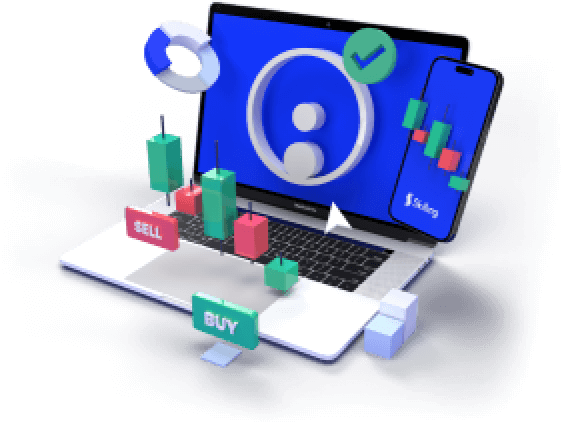Access 1,200+ global CFDs instruments.
Access a plethora of trading opportunities across the financial markets.

Access 1,200+ global CFDs instruments.
Access a plethora of trading opportunities across the financial markets.

Navigating the stock market can be likened to steering through unpredictable currents. Market conditions, much like river flows, can shift suddenly, presenting both opportunities and risks. One such phenomenon that can create significant market turbulence is the gamma squeeze.
This article aims to provide a comprehensive overview of gamma squeezes, including their underlying causes, effects on stock prices, and the risks and opportunities they present.
Defining Gamma Squeeze and its triggers
A gamma squeeze refers to a sharp and sudden increase in a stock’s price, primarily caused by substantial trading volumes of call options over a brief period. The process typically begins when numerous investors purchase call options for a particular stock.
Call options grant the buyer the right, but not the obligation, to purchase a stock at a specified price before the option expires. Market makers, who facilitate these transactions, manage their risk by acquiring the underlying stock.
When a significant volume of call options is bought, market makers are compelled to purchase more of the underlying stock to hedge their positions. This buying pressure can drive the stock price upward. As the stock price rises, more call options become "in the money" (meaning exercising them is profitable), leading to further stock purchases by market makers. This cycle can result in a rapid and dramatic increase in the stock's price, known as a gamma squeeze. It is crucial to understand that a gamma squeeze is a market phenomenon driven by hedging activities rather than manipulation.
Practice with a Demo Account
Try our demo account and experience real market conditions.

Gamma Squeeze vs. Short Squeeze: key differences
Although gamma squeezes and short squeezes might appear similar, they are fundamentally different. A short squeeze occurs when a stock with substantial short interest sees its price rise, forcing short sellers to cover their positions, which in turn drives the price even higher.
Conversely, a gamma squeeze is related to options trading and the need for market makers to hedge their positions. It is driven by the technical aspects of options rather than the direct supply and demand dynamics of the stock itself.
Mechanics of a Gamma Squeeze in stock trading
A gamma squeeze unfolds rapidly, often due to significant options trading in a single security. This leads to changes in dealer hedging practices, which can further elevate stock prices.
To simplify, when many investors buy call options for a stock, market makers need to buy more of the underlying stock to maintain their hedge. This increased buying activity can cause the stock price to rise. As the price climbs, more call options become profitable to exercise, prompting additional stock purchases by market makers and driving the stock price even higher.
This process can lead to a sharp, vertical price increase—a classic gamma squeeze. Understanding that a gamma squeeze is not a form of market manipulation but a result of market participants adjusting their positions is essential.
Notable examples of Gamma Squeezes
GameStop (2021)
A prominent example of a gamma squeeze occurred in January 2021 with GameStop. Retail investors, primarily from the Reddit forum WallStreetBets, purchased a large volume of call options on GameStop stock. This activity forced market makers to buy more shares to hedge their positions, leading to a significant and rapid increase in GameStop’s stock price.
SoftBank (2020)
In 2020, SoftBank became known as the "Nasdaq Whale" due to its extensive buying of tech stock options in the US market. This heavy options activity led market makers to acquire substantial amounts of the underlying stocks, causing notable price movements and a gamma squeeze.
Strategies for trading during a Gamma Squeeze
Trading during a gamma squeeze involves considerable risk and requires precise timing due to the rapid nature of these events. Here are key considerations for trading a gamma squeeze:
- Market Research: Stay informed about market conditions, news, and stock performance.
- Analysis: Use both technical and fundamental analysis to identify potential gamma squeeze opportunities.
- Risk Management: Implement stop-loss orders and only allocate a portion of your portfolio to high-risk trades.
- Timing: Open and close positions with agility, as timing is crucial in gamma squeeze scenarios.
Summary
A gamma squeeze can significantly impact stock prices, creating dramatic upward movements. Understanding the mechanics of a gamma squeeze, especially the role of market makers and options trading dynamics, is essential for investors and traders. While the potential for substantial gains exists, it is important to evaluate risk tolerance and be prepared for rapid market changes.
Capitalise on volatility in share markets
Take a position on moving share prices. Never miss an opportunity.

FAQs
What is a gamma squeeze?
A gamma squeeze is a rapid rise in a stock’s price caused by significant options buying activity, leading to changes in dealer hedging that further push the stock price upward.
How does a gamma squeeze occur?
A gamma squeeze begins when a large volume of call options is purchased for a stock. Market makers hedge their risk by buying the underlying stock, causing the price to rise and more call options to become profitable, leading to a cycle of further stock purchases and price increases.
Is a gamma squeeze legal?
Yes, a gamma squeeze is legal. It is a natural outcome of market participants adjusting their positions based on options trading activity and not a form of market manipulation.
Can a gamma squeeze be predicted?
While predicting a gamma squeeze with certainty is challenging, indicators such as high call option activity and significant short interest in a stock can signal potential occurrences.
What is an example of a gamma squeeze?
A notable example of a gamma squeeze is the GameStop event in January 2021, where increased call option purchases led to a rapid rise in GameStop’s stock price.











